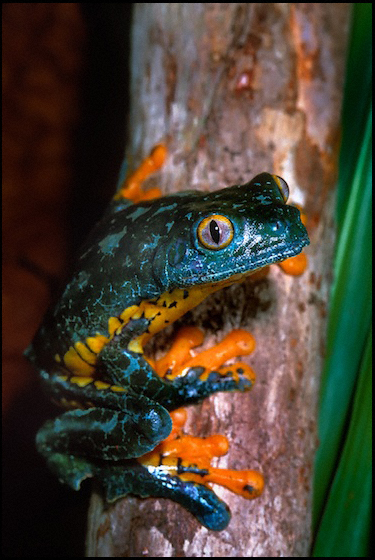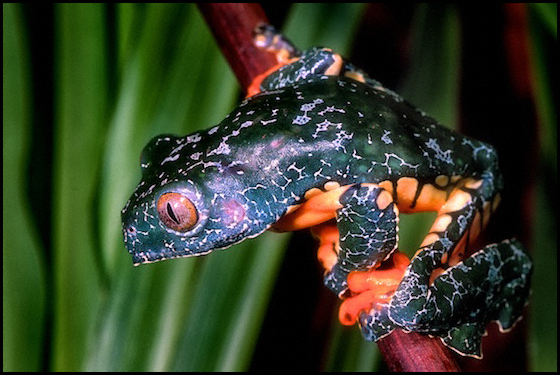Phyllomedusinae – of monkeys and frogs
But the reality is phyllomedusine frogs are way cool, even with an over-saturated representative red-eye species. They are called leaf frogs because most of the species are arboreal and spend their time high up in vegetation and trees excepting to breed. They are also called monkey frogs for their habit to walk and grab, much like monkeys through trees. In recent years there has been much taxonomic work on this monophyletic group of frogs. In 2005 Faivovich, et al., showed that the subfamily Phyllomedusinae was part of the Hylidae family and allied with the Australopapuan subfamily Pelodryinae.

Cruziohyla craspedopus is one of the most stunning of New World hylids and represents one of two species in this genus.
However, uncertainty resided within the family as to species relationships and the monophyly of genera. Faivovich’s review of Hylidae was limited in the sampling of phyllomedusines and supplied another set of questions as to species relationships. In 2009 Faivovich, et al., addressed a number of these questions in a broader study of phyllomedusines. Currently there are about 60 species of phyllomedusines and this recent study included 45 species for genetic comparison. Additionally the authors examined a number of physiological traits in their hope to sort out the relationships both within the subfamily and more importantly in understanding anuran evolution.
Unfortunately, most of these 60 species of leaf frogs reside within the expansive forests of Brazil; a country I’ve not had the pleasure to extensively explore. But there are 7 genera (or 5 if you accept the recent Faivovoch proposal to include Pachymedusa dachnicolor and Hylomantis within Agalychnis) and their ranges extend from Mexico throughout South America so there is plenty of range and diversity to explore. They inhabit lowland tropical forests as well as dry savanna forests. And while most of them are arboreal there are a few species that oddly, at least for this subfamily, appear to be terrestrial. Unfortunately, little is known about most of these species as their ranges and distribution is limited. But there are a few ‘flagship’ representatives that shed some light on their biology.

An Amazonian leaf frog displaying the scallop-fringed limbs, brilliant yellow-orange sides, splotchy blue-green dorsum, and the bi-colored iris.
Faivovich, et al., in 2005 separated Agalychnis calcarifer and A. craspedopus into the new genus Cruziohyla based on morphological and genetic traits. In their 2009 paper this genus along with the southern Brazilian genus Phrynomedusa appear to be sister groups to all the other phyllomedusines. Agalychnis craspedopus is considered one of the most spectacular hylids and tops many peoples’ wish list of must-see, and unfortunately must-own, frogs. In fact I told Bill Lamar that this was my wish list frog on my first trip to Peru in 2001. Thankfully, Greentracks delivered because one of our first nights in the forest we found 2 males and a female at a hollowed out tree stump in a palm swamp. Inside the stump were tadpoles. Hanging off fallen sticks was a fresh egg mass and the jelly remains from a prior egg mass. This stunning frog lives up to its hype. This breeding habit of using tree hollows, along with the bright bi-colored iris, and the striking coloration are some of the physical traits that put this and its sister species, C. calcarifer, in the new genus. The distribution of C. craspedopus is throughout the Amazon basin while C. calcarifer runs down the Atlantic slope of Central America from Nicaragua through Panama where it jumps to the Pacific slope and continues along the coastal forests of Colombia and Ecuador. Despite the great range of C. calcariferit has an extremely patchy distribution, likely the result of habitat degradation, but also potentially subject to chytrid infection, specialized habitat needs, and hopefully under reporting. Many of its known localities are gone or diminishing.

Two male and a female Cruziohyla craspedopus rest on a twig over a hollowed out tree stump. Jelly masses, some with eggs and some previously hatched, remain while tadpoles swim in the water below.







12 comments
Great post Tim! Loved the shots.
Beautiful; well done and very interesting.
Beautiful photos and wonderful information…Thanks for sharing your experiences with us Tim….
Tim, these are some of the most stunning photos of Phyllomedusinae I have yet to come across. Keep up the great work!!!..
Peter
Peter, thanks for the compliments. I’m trying. Waaaay behind on the blog work as I’ve given to some other writing assignments but hoping to tap out more in 2014.
Hello everyone , I’m Alanis.
Welcome to my homepage . I started writing in middle school after a creative writing assignment for my English teacher. I did creative writing for almost a year before I thought about doing something else.
I had always loved doing research assignments because I’m passionate about learning. When you combine writing skill with a love of learning, research paper writing only makes sense as a job.
I’m passionate about helping the students of the future in their school career. When they get too busy, I am there to help.
Alanis – Writing Expert – Greaternewarkcharterschool Corp
My name is Everly. And I am a professional Content writer with many years of experience in writing.
My main focus is to solve problems related to writing. And I have been doing it for many years. I have been with several groups as a volunteer and have assisted clients in many ways.
My love for writing has no end. It is like the air we breathe, something I cherish with all my being. I am a full-time writer who started at an early age.
I’m happy that I`ve already sold several copies of my works in different countries like Canada and China and others too numerous to mention.
I also work in an organization that provides assistance to many people from different parts of the world. Students always come to me because I work no matter how hard their projects are. I help them to save energy, because I feel happy when people come to me for writing help.
Academic Writer – Everly – //nametheschool.com/]Nametheschool Band
мостбет промокод – мелбет промокод при регистрации, 1хбет промокод на сегодня
Change Reach For The Sky Anthology https://nytimes.ysr.org.uk/38.html Avalon The Remixes Vol 2 Part One
Grapefruit can increase the amount of this medication in your bloodstream. Consult your doctor or pharmacist for more details.
site
q0uqn5
bp0n38